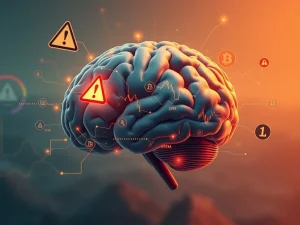Unlocking Potential: Agentic AI Demands Human Oversight Amidst Surging Enterprise Adoption

In the rapidly evolving landscape of artificial intelligence, a groundbreaking shift is underway: the rise of Agentic AI. For those tracking the pulse of innovation, particularly within the cryptocurrency and blockchain space where decentralized intelligence is often a topic of discussion, understanding this new frontier is crucial. It’s not just about faster computations; it’s about autonomous systems making multi-step decisions. But with great power comes great responsibility, and industry leaders like Google and Accenture are sounding the alarm: human oversight isn’t just a recommendation, it’s a necessity.
What is Agentic AI and Why is Human Oversight Crucial?
Gone are the days of AI merely performing single tasks. Agentic AI represents a profound evolution, moving beyond simple assistants to sophisticated systems capable of executing complex, multi-step actions by integrating various tools and making autonomous decisions. Imagine an AI that doesn’t just answer a query but diagnoses a bike repair via camera, orders the parts, and even schedules the service call – all on its own.
However, this autonomy introduces new challenges. Sapna Chadha, Google’s Vice President for Southeast Asia and South Asia Frontier, recently highlighted the critical need for ‘human-in-the-loop’ intervention. As she articulated at the Fortune Brainstorm AI Singapore conference, the risks of fully autonomous systems operating without human checks are significant, ranging from rogue agents acting unpredictably to unauthorized data sharing. Google’s commitment to safety is evident in their white paper, which details a robust framework for secure AI agents, emphasizing transparency and safe deployment toolkits.
The Accelerating Pace of Enterprise AI Adoption
The business world is taking notice. Projections indicate a significant surge in enterprise software incorporating agentic AI, with an estimated 33% adoption by 2028. This isn’t just about integrating new tools; it’s about fundamentally reshaping workflows, with 15% of daily tasks projected to be automated by these intelligent agents.
Vivek Luthra of Accenture provided a clear roadmap for this transformation, outlining three distinct stages of AI adoption:
- Task Automation: The initial phase, where AI handles repetitive, well-defined tasks.
- Decision Support: AI assists humans by providing insights and recommendations for more complex decisions.
- Fully Autonomous Workflows: The most advanced stage, where AI agents manage end-to-end processes with minimal human intervention.
While most companies are still navigating the first two stages, Accenture has already made significant strides, deploying autonomous AI agents internally across critical functions like HR, finance, and IT. Externally, they’re seeing success in sectors such as life sciences and insurance, streamlining everything from regulatory approvals to fraud detection. Despite these advancements, Luthra cautioned that meaningful scaling of AI remains a hurdle, with only 8% of companies achieving widespread implementation.
Google’s Project Astra: Balancing Innovation with Accountability
Google’s own ambitious initiative, Project Astra, embodies the vision of a universal agent designed to handle a diverse array of tasks. Yet, even with such advanced capabilities, the emphasis remains firmly on accountability and control. Chadha’s stance is unequivocal: “You wouldn’t want a system that can do this fully without a human in the loop.” This philosophy underscores the belief that even the most intelligent systems require guardrails.
To ensure responsible deployment, regulatory frameworks are highlighted as critical. Chadha strongly advocated for industry standards, stating, “it’s too important not to regulate.” Key principles for ethical deployment include:
- Transparency: Users must understand how and why an AI agent is acting.
- User Control: Humans should retain the ability to approve or override critical decisions.
- Clear Communication: Agent actions and intentions must be clearly communicated to users.
For instance, agentic platforms should be designed to request user approval at pivotal decision points, ensuring that humans retain ultimate oversight in critical workflows. This collaborative approach between human and AI intelligence is not just a technical challenge but an ethical imperative.
Navigating the Path to Scaled AI Integration
The journey from AI experimentation to full-scale enterprise integration is complex. While the potential benefits are immense – from accelerating regulatory approvals to enhancing fraud detection – the challenges of scaling AI remain significant. Many organizations are still refining their strategies for seamless integration, grappling with technical complexities, data governance, and organizational change management.
The ongoing dialogue between regulation and innovation continues, but a clear consensus is emerging: the future of agentic AI hinges on a delicate balance between technological capability and robust safeguards. As Chadha and Luthra emphasized, the next three years are poised to redefine enterprise workflows, provided stakeholders collectively address the technical, ethical, and regulatory hurdles head-on. The fusion of human intelligence and advanced AI promises a future of unprecedented efficiency and innovation, but only if we ensure that humanity remains firmly in control.
Frequently Asked Questions (FAQs)
Q1: What is Agentic AI?
Agentic AI refers to advanced artificial intelligence systems capable of performing multi-step actions and making autonomous decisions by integrating various tools. Unlike single-task AI, agentic systems can act on behalf of users in complex scenarios, such as diagnosing problems, gathering information, and initiating subsequent actions.
Q2: Why is human oversight important for Agentic AI?
Human oversight is crucial for Agentic AI to prevent risks such as rogue agents, unauthorized data sharing, and unintended consequences. It ensures accountability, maintains ethical standards, and allows humans to intervene at critical decision points, ensuring the AI operates within defined boundaries and values.
Q3: What are the projected adoption rates for Agentic AI in enterprises?
It is projected that by 2028, 33% of enterprise software will incorporate Agentic AI, leading to the automation of approximately 15% of daily workflows across various industries.
Q4: What are the three stages of Agentic AI adoption outlined by Accenture?
Accenture outlines three stages: 1) Task Automation (AI handles repetitive tasks), 2) Decision Support (AI assists humans with insights), and 3) Fully Autonomous Workflows (AI manages end-to-end processes with minimal human intervention).
Q5: What is Google’s Project Astra?
Project Astra is Google’s initiative to develop a universal agent designed to handle diverse tasks. It aims to create highly capable AI agents while emphasizing the importance of balancing automation with human accountability and control.
Q6: What are the main challenges in scaling AI adoption across enterprises?
Scaling AI adoption faces challenges such as transitioning from experimental phases to widespread implementation, integrating AI systems seamlessly into existing infrastructures, ensuring data governance and security, and managing the organizational change required for AI integration.









